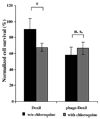Cytoplasmic delivery of liposomes into MCF-7 breast cancer cells mediated by cell-specific phage fusion coat protein
- PMID: 20438086
- PMCID: PMC2914188
- DOI: 10.1021/mp1000229
Cytoplasmic delivery of liposomes into MCF-7 breast cancer cells mediated by cell-specific phage fusion coat protein
Abstract
Earlier, we have shown that doxorubicin-loaded liposomes (Doxil) modified with a chimeric phage fusion coat protein specific toward MCF-7 breast cancer cells identified from a phage landscape library demonstrated a significantly enhanced association with target cells and an increased cytotoxicity. Based on some structural similarities between the N-terminus of the phage potein and known fusogenic peptides, we hypothesized that, in addition to the specific targeting, the phage protein may possess endosome-escaping potential and an increased cytotoxicity of drug-loaded phage protein-targeted liposomes may be explained by an advantageous combination of both, cell targeting and endosomal escape of drug-loaded nanocarrier. The use of the fluorescence resonance energy transfer (FRET) technique allowed us to clearly demonstrate the pH-dependent membrane fusion activity of the phage protein. Endosomal escape and cytosolic delivery of phage-liposomes was visualized with fluorescence microscopy. Endosome acidification inhibition by bafilomycin A 1 resulted in decreased cytotoxicity of the phage-Doxil, while the endosome disruption by chloroquine had a negligible effect on efficacy of phage-Doxil, confirming its endosomal escape. Our results demonstrated an endosome-escaping property of the phage protein and provided an insight on mechanism of the enhanced cytotoxicity of phage-Doxil.
Figures






Similar articles
-
Enhanced binding and killing of target tumor cells by drug-loaded liposomes modified with tumor-specific phage fusion coat protein.Nanomedicine (Lond). 2010 Jun;5(4):563-74. doi: 10.2217/nnm.10.30. Nanomedicine (Lond). 2010. PMID: 20528452 Free PMC article.
-
Liposomes targeted by fusion phage proteins.Nanomedicine. 2009 Mar;5(1):83-9. doi: 10.1016/j.nano.2008.07.006. Epub 2008 Oct 1. Nanomedicine. 2009. PMID: 18838343 Free PMC article.
-
Landscape phage fusion protein-mediated targeting of nanomedicines enhances their prostate tumor cell association and cytotoxic efficiency.Nanomedicine. 2010 Aug;6(4):538-46. doi: 10.1016/j.nano.2010.01.005. Epub 2010 Feb 4. Nanomedicine. 2010. PMID: 20138246 Free PMC article.
-
On the mechanism of targeting of phage fusion protein-modified nanocarriers: only the binding peptide sequence matters.Mol Pharm. 2011 Oct 3;8(5):1720-8. doi: 10.1021/mp200080h. Epub 2011 Jul 29. Mol Pharm. 2011. PMID: 21675738 Free PMC article.
-
Enhanced tumor delivery and antitumor activity in vivo of liposomal doxorubicin modified with MCF-7-specific phage fusion protein.Nanomedicine. 2014 Feb;10(2):421-30. doi: 10.1016/j.nano.2013.08.009. Epub 2013 Sep 9. Nanomedicine. 2014. PMID: 24028893 Free PMC article.
Cited by
-
Achieving Endo/Lysosomal Escape Using Smart Nanosystems for Efficient Cellular Delivery.Molecules. 2024 Jul 1;29(13):3131. doi: 10.3390/molecules29133131. Molecules. 2024. PMID: 38999083 Free PMC article. Review.
-
Guiding nanomaterials to tumors for breast cancer precision medicine: from tumor-targeting small-molecule discovery to targeted nanodrug delivery.NPG Asia Mater. 2017;9:e452. doi: 10.1038/am.2017.196. Epub 2017 Dec 8. NPG Asia Mater. 2017. PMID: 29657602 Free PMC article.
-
Landscape phages and their fusion proteins targeted to breast cancer cells.Protein Eng Des Sel. 2012 Jun;25(6):271-83. doi: 10.1093/protein/gzs013. Epub 2012 Apr 6. Protein Eng Des Sel. 2012. PMID: 22490956 Free PMC article.
-
Paclitaxel-loaded polymeric micelles modified with MCF-7 cell-specific phage protein: enhanced binding to target cancer cells and increased cytotoxicity.Mol Pharm. 2010 Aug 2;7(4):1007-14. doi: 10.1021/mp1001125. Mol Pharm. 2010. PMID: 20518562 Free PMC article.
-
Antimicrobial peptide AR-23 derivatives with high endosomal disrupting ability enhance poly(l-lysine)-mediated gene transfer.J Gene Med. 2020 Nov;22(11):e3259. doi: 10.1002/jgm.3259. Epub 2020 Aug 28. J Gene Med. 2020. PMID: 32776410 Free PMC article.
References
-
- Torchilin VP. Recent Advances with Liposomes as Pharmaceutical Carriers. Nat Rev Drug Discov. 2005;4(2):145–160. - PubMed
-
- Klibanov AL, Maruyama K, Torchilin VP, Huang L. Amphipathic Polyethyleneglycols Effectively Prolong the Circulation Time of Liposomes. FEBS Lett. 1990;268(1):235–237. - PubMed
-
- Blume G, Cevc G. Molecular Mechanism of the Lipid Vesicle Longevity in Vivo. Biochim Biophys Acta. 1993;1146(2):157–168. - PubMed
-
- Torchilin VP, Omelyanenko VG, Papisov MI, Bogdanov AA, Trubetskoy VS, Herron JN, Gentry CA. Poly(ethylene glycol) on the Liposome Surface: on the Mechanism of Polymer-Coated Liposome Longevity. Biochim Biophys Acta. 1994;1195(1):11–20. - PubMed
-
- Park JW, Kirpotin DB, Hong K, Shalaby R, Shao Y, Nielsen UB, Marks JD, Papahadjopoulos D, Benz CC. Tumor Targeting Using Anti-Her2 Immunoliposomes. J Control Release. 2001;74(1–3):95–113. - PubMed
Publication types
MeSH terms
Substances
Grants and funding
LinkOut - more resources
Full Text Sources
Other Literature Sources
Medical

